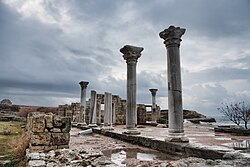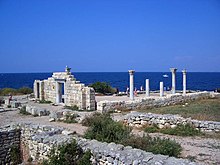Chersonese (city)
| Ancient city in the Tauride Chersonese and its Chora | |
|---|---|
|
UNESCO world heritage |
|

|
|
| Ruins of the basilica, built from the late 6th century to around 1100 |
|
| National territory: |
|
| Type: | Culture |
| Criteria : | (ii) (v) |
| Surface: | 259.3752 ha |
| Buffer zone: | 3,041.0876 ha |
| Reference No .: | 1411 |
| UNESCO region : | Europe and North America |
| History of enrollment | |
| Enrollment: | 2013 (session 37) |
The ancient city of Chersonese or Chersonesus ( Greek Χερσόνησος , Chersonesos , or Χερσόνασος, Chersónāsos , Peninsula), initially Heraclea , then the withdrawal of other same settlements also Taurian Chersonesos ( Greek Χερσόνησος Ταυρική , Chersonesos Taurikḗ ; lat. Chersonesus Taurica ), in Byzantine times, finally called Cherson ( Greek Χερσών , Chersṓn ), lies on the south bank of the largest of the 38 bays of Sevastopol ( Sevastopol'skaya buchta ), protected behind some hills, on the extreme southwestern tip of the Crimean peninsula on the Black Sea . Today's city of Sevastopol was founded in the immediate vicinity of Chersonese in 1783 .
prehistory
Even 300,000 years ago, early humans are said to have settled in caves and grottos near Chersonese.
Greek city-state and Bosphoran Empire


In the 6th century BC The first Greek colonies arose in the Crimea. The Greeks drove out the Taurians , who were considered to be predatory, and built fortresses with associated ports. There is evidence that they first grew wine, grain and fruit in the Crimea (in protected locations). The Crimea was divided geographically: the Ionian colonists from Miletus founded Theodosia (today's Feodosia ), Pantikapaion (today, Myrmikon or Mirmekion ) and Nymphaion on the Kerch peninsula in the east of the Crimea on the Sea of Azov , while Doric colonists from Herakleia Pontike founded the southwest populated the Crimea. This is where Kerkinitis (today Evpatorija ), Kalamita (today Sevastopol ), Kalos Limen ( Greek Καλὸς Λιμήν "good harbor", today Tschornomorske ) and Chersonese, which was initially named after the Pontic mother city, Herakleia , originated . According to the Periegesis of Pseudo-Skymnos (last third of the 2nd century BC), Deli settlers were also involved in the establishment of the colony , which is a date of foundation around 422 BC. BC probably when the Delians were driven from their island by the Athenians. The population of early Chersonese is still considered predominantly Doric due to the private inscriptions found.
In the 5th century BC The Greek colonies north of the Black Sea united - under the leadership of the Archaianaktiden from Pantikapaion - to form the Bosporan Empire . In the 2nd century BC When the Scythians attacked the Greeks, the Greek polis Chersoneses could no longer protect itself alone and therefore had to ask the king of Pontus for help. As a result, the cultural and economic center of south-western Crimea lost its independence. In 107 BC The northern Pontic pole ice was annexed by the kingdom of Pontus .
Roman outpost and Khazar Khanate
After Pompey took power from the Pontic king Mithridates in 63 BC. After it had broken in BC, the townspeople of Chersonese placed themselves under the protection of Rome. The Bosporan Empire became the client state of the Roman Empire. From then on, Chersonesus served as an outpost of the Roman policy of conquest on the northern shore of the Black Sea. The coins of the city of Chersonesos from the imperial era bear witness to the enduring spirit of independence, with inscriptions such as Chersonesou eleutheras ("the free Chersonesos") or even basileuousas ("the ruling ones "), but neither the names nor the heads of kings or emperors.
The city remained as a Roman-Byzantine trading outpost until the late 7th century with the empire and served it as a place of exile, including for Pope Martin I. Emperor Justinian II was also exiled there after his first fall in 695.
During the Byzantine iconoclasm in the 8th and 9th centuries, Chersonese was under Khazar influence and for Byzantium was more of a trading post than a military base. This made it a refuge for Byzantine admirers of images during the reign of emperors who were hostile to images.
Byzantine period
In return for helping to build the Khazarian fortress Sarkel at the mouth of the Don , Byzantium regained control of the city of Chersonese in 838, which then retained its Greco-Byzantine character until it was destroyed around 1400.
Around 985, the Kiev Grand Duke Vladimir I, who was allied with Byzantium against Bulgaria, occupied the city with the aim of forcing her to marry Anna, the sister of the Byzantine emperor. Byzantium agreed, but in addition to the return of Chersonese, made the baptism of Vladimir and the Christianization of Rus a condition for marriage.
The Byzantine rule continued until the 4th Crusade in 1204, after which Chersonese fell first to the Byzantine kingdom of Trebizond and then in the further course of the early 13th century to the Republic of Genoa , until it was finally destroyed by the White Horde around 1400 and was not rebuilt afterwards.

Russian start-up

In 1783, Tsarina Catherine II founded the city of Sevastopol next to Chersonese. The ancient Chersonese was not built over. Around 1820 Russian archaeologists began excavating and uncovering parts of the city. The Soviet Black Sea Fleet was less considerate than Catherine II. It erected military structures in the middle of the excavation area, but these have now been dismantled.
Chersonese today
Today you can visit the archaeological and historical open-air museum "Chersonese of Tauria". In summer the annual theater festival The Games of Chersonese takes place here in the exposed amphitheater . Since the summer of 2013, Chersonese has been a World Heritage Site.
The main inner belt asteroid (2966) Korsunia is named after the city.
Others
On Crete there were two other ancient settlements similar name:
- Chersonasos , located on the very western tip of Crete between Platanos and Stomio on the coast, and
- Chersonasos (or Chersonaos ) on the northeast coast of Crete, north of today's Chersonissos , between Heraklion and Malia .
literature
- Karl Georg Brandis : Chersonesos 20 . In: Paulys Realencyclopadie der classischen Antiquity Science (RE). Volume III, 2, Stuttgart 1899, Col. 2261-2269.
- Sergei Kovalenko: The late classical coinage of Chersonesos Taurica ( Greek coin factory , published by the Berlin-Brandenburg Academy of Sciences), translated by Ulrike Peter. Akademie-Verlag, Berlin 2008.
Web links
- Literature about Chersonese in the catalog of the German National Library
Individual evidence
- ↑ Wolfgang Schuller: Greek History . Oldenbourg, Munich 2008, p. 14 .
-
^ Ulrich Wilcken: Greek history in the context of antiquity . Oldenbourg, Munich and Vienna 1973, p. 91 f.
Hermann Bengtson: Greek History. From the beginning to the Roman Empire . CH Beck, Munich 1979, p. 74 . - ↑ Sergei Kovalenko: The late classical coinage of Chersonesos Taurica . Akademie-Verlag, Berlin 2008, p. 11 f.
- ↑ Alfred von Sallet: The coins of Chersonesus in the Crimea. In: Journal of Numismatics. Vol. 1, 1874, ZDB -ID 501259-4 , pp. 17-32, here p. 27; Alfred von Sallet: A gold stater of the Tauride Chersonesus with the nickname BACIΛEYOYCA and a year of the Chersonese era. In: Journal of Numismatics. Vol. 4, 1877, pp. 273-277, here p. 275 ( online ).
- ↑ See the English article on the Bell of Chersonesos .
- ↑ Unesco names Kassel Hercules World Heritage , on Spiegel Online June 23, 2013.
- ^ Lutz D. Schmadel : Dictionary of Minor Planet Names . Fifth Revised and Enlarged Edition. Ed .: Lutz D. Schmadel. 5th edition. Springer Verlag , Berlin , Heidelberg 2003, ISBN 978-3-540-29925-7 , pp. 186 (English, 992 pp., Link.springer.com [ONLINE; accessed on September 27, 2019] Original title: Dictionary of Minor Planet Names . First edition: Springer Verlag, Berlin, Heidelberg 1992): “1977 EB 2 . Discovered 1977 Mar. 13 by NS Chernykh at Nauchnyj. "
Coordinates: 44 ° 36 ′ 41 ″ N , 33 ° 29 ′ 31 ″ E



